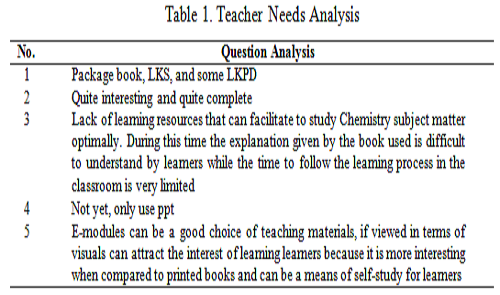Analysis of Module Needs as Chemical Teaching Materials on Colloidal Subjects in SMA Negeri 1 Tembilahan
DOI:
https://doi.org/10.31258/jes.6.4.p.645-652Keywords:
Analysis, Teaching Materials, ColloidAbstract
The purpose of this study was to analyze the needs of teachers and students on the use of modules as colloidal teaching materials at SMAN 1 Tembilahan. This type of research is descriptive with a qualitative approach. Collecting data using interview sheets and questionnaires. The subjects of this study were three teachers and ten students of class XII IPA 3 SMAN 1 Tembilahan. Based on the results of the questionnaire given, 100% of teachers have used teaching materials that are in accordance with the 2013 curriculum. As many as 67% of teachers experience limited handbooks, both in terms of completeness of materials, explanation techniques, and examples of applying concepts in everyday life. For the use of other teaching materials (outside of school handbooks), only 33% used them while the rest had not used other teaching materials. Regarding the use of application-based teaching materials during the learning process, 100% of teachers have never used them. 33% of teachers have developed teaching materials in the form of modules independently and the rest have never. 100% of teachers expressed interest in the electronic module. From the results of the questionnaire analysis of student needs, it can be concluded that students need a teaching material that can help them to more easily understand chemical concepts and the teaching materials are equipped with pictures, videos, and animations so that learning becomes more interesting and interactive.
Downloads

Downloads
Published
Issue
Section
License

This work is licensed under a Creative Commons Attribution-NonCommercial-ShareAlike 4.0 International License.












